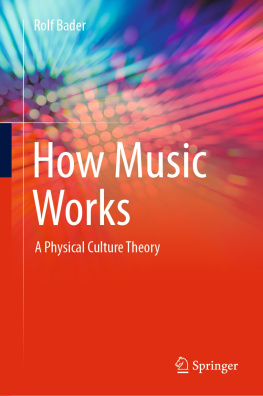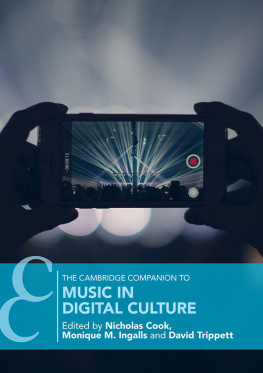Rolf Bader
Institute of Systematic Musicology, University of Hamburg, Hamburg, Germany
ISBN 978-3-030-67154-9 e-ISBN 978-3-030-67155-6
https://doi.org/10.1007/978-3-030-67155-6
The Editor(s) (if applicable) and The Author(s), under exclusive license to Springer Nature Switzerland AG 2021
This work is subject to copyright. All rights are solely and exclusively licensed by the Publisher, whether the whole or part of the material is concerned, specifically the rights of translation, reprinting, reuse of illustrations, recitation, broadcasting, reproduction on microfilms or in any other physical way, and transmission or information storage and retrieval, electronic adaptation, computer software, or by similar or dissimilar methodology now known or hereafter developed.
The use of general descriptive names, registered names, trademarks, service marks, etc. in this publication does not imply, even in the absence of a specific statement, that such names are exempt from the relevant protective laws and regulations and therefore free for general use.
The publisher, the authors and the editors are safe to assume that the advice and information in this book are believed to be true and accurate at the date of publication. Neither the publisher nor the authors or the editors give a warranty, expressed or implied, with respect to the material contained herein or for any errors or omissions that may have been made. The publisher remains neutral with regard to jurisdictional claims in published maps and institutional affiliations.
This Springer imprint is published by the registered company Springer Nature Switzerland AG
The registered company address is: Gewerbestrasse 11, 6330 Cham, Switzerland
Introduction
This book is about how music, and therefore, how art and culture work: as a self-organizing system. Such systems maintain a low level of entropy or a high level of order. All living systems, men, animals, or plants are self-organizing. They are maintaining their lives through self-organizing processes. So do music, art, and culture. The book tries to show this in the field of music on a physical basis, in musical acoustics, music psychology and brain research, and music ethnology, the music from all over the world.
The Physical Culture Theory therefore is:
Culture is a system of physical human-made objects, like musical instruments, as well as human brains and bodies interacting to extend life by building self-organizing systems aiming for maintaining life as a state far from random. The spatial and temporal fields of culture are then an interplay of order with intermediate chaotic states.
Conscious content, which is perceptual phenomena, qualia, notions, or feelings, are electromagnetic spatiotemporal fields in the brain. Cultural notions and understandings, sounds and timbre, vision, memories, self-consciousness, and all kinds of conscious content, like electromagnetic fields, are, therefore, only one element in culture, which consists of both, man-made objects and humanas well as animalbrains and bodies.
Culture can be modeled purely in the physical domain by spatiotemporal fields of energy bursts, impulses, on different time scales, interacting with the subsystems, objects, and brains, nonlinearly to arrive at self-organizing states of order and chaos. These impulses can be wave packages in musical instruments, spikes and spike bursts in the brain, or bits and data packages in internet information streams.
Three major findings can be derived for music and arts from such a Physical Culture Theory:
Music is food. Due to the self-organization in musical instruments, the sounds they make have a low entropy, or a high level of order. When listening, this low entropy is lowering the entropy of our brains on a physical basis. Just like food feeding us through its energy with low entropy, music is feeding us in the same way.
Music, art, and culture are Human Rights. Human Rights are therefore derived from mans characteristics. Musical instruments have been built by humans. The instruments work such that they have a low entropy, interacting with us in a way of feeding us. Therefore, we have built musical instruments to enlarge our bodies and brains. This holds for arts and culture in general. Therefore, music, art, and culture determine us as humans, and therefore, they are a Human Right.
Music, art, and culture are ethical. Entropic imperative. As all life is slowing down the increase of entropy on earth by an endless complexity of structures, to maintain life, one needs to build such complex structures. Music, art, and culture are such self-organizing systems. Therefore, they help to maintain life. So we can formulate an entropic imperative: Act such that your doing builds structures which slow down the increase of entropy! This entropic imperative also holds for environmental, political, or social issues.
Therefore, this book introduces a Physical Culture Theory exemplified with music, showing how musical instruments work, how their sound is processed in self-organizing brain structures, how conscious content appears in humans, and how this is dealt with in the music around the world.
Energy and entropy are closely aligned. A steam engine has a tank filled with heated water. So there is a lot of energy in this water. Still, to use the heat for driving the engine, there needs to be cold air outside the tank. Only because of the difference in pressure and heat inside and outside the tank, this pressure and heat wants to get out of the tank. If outside the tank, the same pressure and heat would be present, the steam in the tank would not move out and could not be used for doing work, for driving the engine. Therefore, no matter how much energy there is, the energy needs some kind of order, low entropy, to perform work. With the steam engine, order means that not the same temperature and pressure exist all over the place, but that there is a region of high pressure, the tank, and a region of low pressure, outside the tank.
The sun provides the earth with heat, which gives life to everything. Still, on Mars, the sun shines too without any life up there. The reason Mars is dead is that Mars has nearly no atmosphere, no plants, animals, or any other self-organizing being with a very complex molecular structure to keep entropy low. There is an endless cascade of processes, structures, and performances of living beings to lower the entropy as much as possible. Physics tells us that entropy always increases. Disorder always wins. Still, life on earth slows down this increase of entropy by beings that take the energy and use it for maintaining their own lives, self-organize in a way to maintain their very complex structures. Energy does not arise from nowhere or from nothing and does not vanish into nowhere or into nothing. It is only changing its nature, from heat to force, from speed to height, etc. Still, within this process, the energy is distributed more and more equally over a spatial field, it lowers its order, entropy increases. Of course, in the end, all energy is distributed equally. Entropy has won. Still, life on earth slows down that increase of entropy tremendously, with its endless diversity of plants, animals, humansand culture. On Mars, the suns energy heats the Mars surface during the daytime, which cools down at night nearly entirely again. Therefore, entropy has maximized within one day. On earth, trees take over the suns energy, grow wood and leaves, storing energy in complex structures, maintaining low entropy, sometimes for millions of years as oil or gas.










